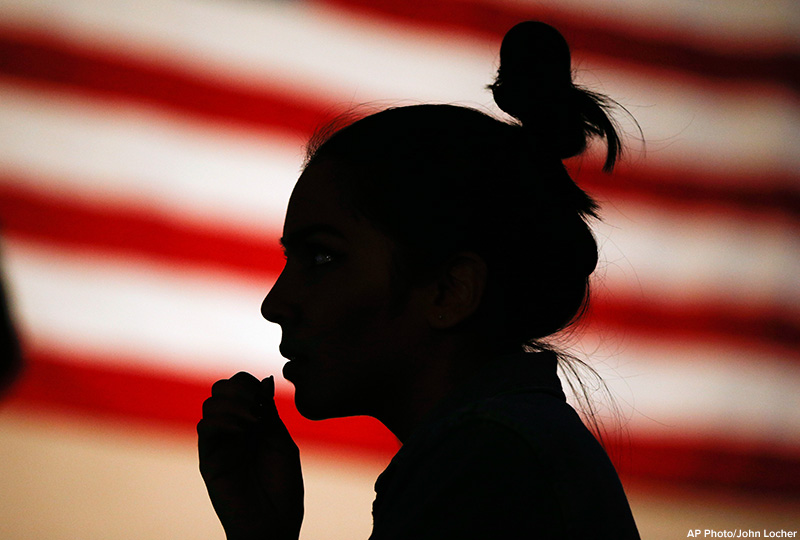
Credit: AP Photo/John Locher.
The Latino voter is an important focus of many presidential hopefuls.
Examining the Power of the Latino Vote
Our country is well on its way to becoming one where the majority of the population is made up of minorities. Latinos in particular are the largest-growing minority group in the United States. (Hispanic is often used interchangeably.) But the individual cultures that make up this designation have very specific characteristics and can differ from one another quite a bit.
In the fall, we celebrate Hispanic Heritage Month in the United States. As we continue to ramp up into election season, we take a closer look at this ethnic group made up of many different cultures and its influence on potential candidates.
Division by Origin
Latino (and Hispanic) is a self-identified label and can be based on place of birth or ancestry. This means that someone can be born in the United States but have immigrant parents or grandparents. Many Latinos identify by a specific country.
Mexican
65 percent of the U.S. Latino population
Making up the largest percentage, by far, of the Hispanic population in the US., the Mexican population has the lowest median age (25 years) and is largely concentrated in Western states.
Puerto Rican
9 percent of the U.S. Latino population
Even though it is a U.S. territory, voters who live in Puerto Rico are not eligible to vote in federal elections. However, both parties allow the territory to select delegates to represent them at its nominating conventions.
Cuban
4 percent of the U.S. Latino population
This population is the most concentrated of all Hispanics in the U.S., with nearly half residing in Miami, Florida. There have been historical resentments between Cuban and Mexican immigrants because of the difference in their status Because Cuba is a communist country they have certain protections not granted to Mexicans.
Salvadoran
4 percent of the U.S. Latino population
Immigrants from the island of El Salvador have shown a tendency to invest heavily in their native country, often sending some of the wages earned in the U.S. back home to invest in small business and real estate.
Dominican, Guatemalan, or Columbian
2 percent (each) of the U.S. Latino population
Columbians are more likely than any of the other Hispanic groups to have a college degree.
Honduran, Ecuadorian, or Peruvian
1 percent (each) of the U.S. Latino population
Ecuadorians have the highest annual median household income among the Latino groups living in the United States.
Political Affiliations and Today’s Candidates
In general, more than half of Latinos identify as Democrat (many of them Mexican, Puerto Rican and Dominicans) and nearly half as Republican (mostly Cuban and Columbians). This leaves a significant influence gap for candidates of each party to try to persuade voters. Historically, Latinos are liberal on some issues (believing in an “active and efficient government”) and conservative on others (a strong commitment to faith and traditional family values). Many Latinos have expressed their disappointment with President Obama’s inability to deliver on promises to overhaul deportation procedures.
Here’s a look at how current candidates might fare with Latino voters:
- Bernie Sanders – Similar to his overall appeal, the Vermont senator is winning favor with young and first-time voters looking for change. He has a chance for victory in places like Arizona, California and Florida, where the Latino vote is pivotal.
- Ted Cruz – Cruz is a Cuban-American. His home state of Texas (which he won in the latest primary), is seeing an increasing number of Latino Republicans running for office. But Cruz’ record of only receiving 35 percent of the Hispanic vote during his 2012 Senate race makes many question his ability to appeal to Latinos overall.
- Hillary Clinton – Her immigration policy platform, which calls for a “pathway to citizenship” and a reform on inhumane detention practices, has been called one fo the most progressive of all the candidates. She recently captured 71 percent of the Hispanic vote in Texas.
- Marco Rubio – Rubio is also a Cuban-American (his parents were from Cuba). His relationship with Latino voters is similar to that of Cruz in that many Latinos tend to disagree with both men’s positions on immigration reform. But Rubio does lead current polls among Republican Latinos.
- John Kasich – The Ohio governor has not gotten the attention he would like. Back in the fall, while addressing a group of supporters, he made a comment about an exchange he had with a hotel maid that many took to be a insensitive generalization of Hispanics as “service workers.”
- Donald Trump – Despite a string of offensive public statements toward some segments of the Latino populaton, Trump has managed to sweep the vote in many of the states where the Hispanic vote is significant. On the other hand, many previously unregistered Latinos are reportedly signing up in order to vote against him.
Dig Deeper Are you a Latino? If so, which candidate most appeals to you and why? How about your family? If you are not Latino, ask someone who is the same question and record his or her answer.
David Martin



